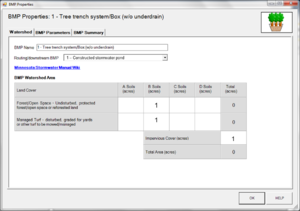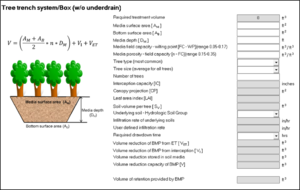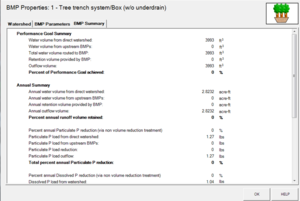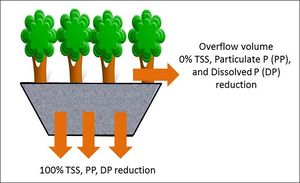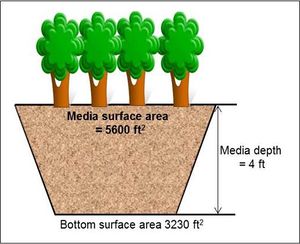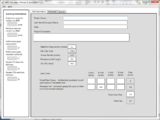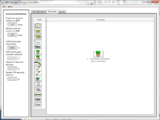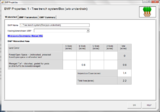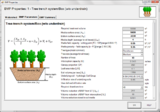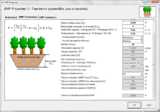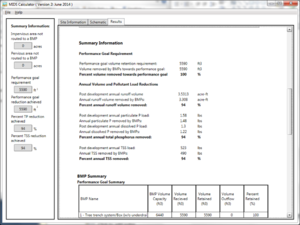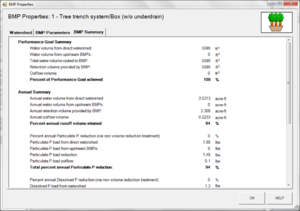
Difference between revisions of "Requirements, recommendations and information for using trees as a BMP in the MIDS calculator"
| Line 12: | Line 12: | ||
[[File:BMP Parameters tab tree trench no underdrain.png|300px|thumb|alt=schematic of BMP Parameters tab for tree trench in MIDS calculator|<font size=3>Schematic of the BMP Parameters tab for tree trench system-tree box BMP in the MIDS calculator.</font size>]] | [[File:BMP Parameters tab tree trench no underdrain.png|300px|thumb|alt=schematic of BMP Parameters tab for tree trench in MIDS calculator|<font size=3>Schematic of the BMP Parameters tab for tree trench system-tree box BMP in the MIDS calculator.</font size>]] | ||
| + | |||
| + | [[File:BMP Summary tab tree trench no underdrain.png|300px|thumb|alt=schematic of BMP Summary tab for tree trench in MIDS calculator|<font size=3>Schematic of the BMP Summary tab for tree trench system-tree box BMP in the MIDS calculator.</font size>]] | ||
For ''Tree trench system/tree box without an underdrain'' BMPs, the user must input the following parameters to calculate the volume and pollutant load reductions associated with the BMP. | For ''Tree trench system/tree box without an underdrain'' BMPs, the user must input the following parameters to calculate the volume and pollutant load reductions associated with the BMP. | ||
| Line 28: | Line 30: | ||
**Number of trees: The user enters the total number of trees planted in the tree trench/tree box system. | **Number of trees: The user enters the total number of trees planted in the tree trench/tree box system. | ||
**Underlying soil - Hydrologic Soil Group: The user selects the most restrictive soil (lowest hydraulic conductivity) within 3 feet of the soil/media interface in the tree trench/box. There are 14 soil options that fall into 4 different [[Glossary#H|Hydrologic Soil Groups]] (Hydrologic Soil Group (HSG) A, B, C, or D) for the user. These correspond with [[Design infiltration rates|soils and infiltration rates]] contained in this Manual. Once a soil type is selected, the corresponding infiltration rate will populate in the “Infiltration rate of underlying soils” field. The user may also select “User Defined.” This selection will activate the “User Defined Infiltration Rate” cell allowing the user to enter a different value from the values in the predefined selection list. The maximum allowable infiltration rate is 1.63 inches per hour. | **Underlying soil - Hydrologic Soil Group: The user selects the most restrictive soil (lowest hydraulic conductivity) within 3 feet of the soil/media interface in the tree trench/box. There are 14 soil options that fall into 4 different [[Glossary#H|Hydrologic Soil Groups]] (Hydrologic Soil Group (HSG) A, B, C, or D) for the user. These correspond with [[Design infiltration rates|soils and infiltration rates]] contained in this Manual. Once a soil type is selected, the corresponding infiltration rate will populate in the “Infiltration rate of underlying soils” field. The user may also select “User Defined.” This selection will activate the “User Defined Infiltration Rate” cell allowing the user to enter a different value from the values in the predefined selection list. The maximum allowable infiltration rate is 1.63 inches per hour. | ||
| − | |||
| − | |||
| − | |||
**Required drawdown time (hrs): This is the time in which the stormwater captured by the BMP must drain into the underlying soil/media. The user may select from predefined values of 48 or 24 hours. The MPCA [http://www.pca.state.mn.us/index.php/water/water-types-and-programs/stormwater/construction-stormwater/index.html Construction Stormwater General Permit] requires drawdown within 48 hours, but 24 hours is ''Highly Recommended'' when discharges are to a trout stream. The calculator uses the underlying soil infiltration rate and the media depth times porosity to check if the BMP is meeting the drawdown time requirement. The user will encounter an error and be required to enter a new “Media depth” if the stormwater stored in the BMP cannot drawdown in the required time. | **Required drawdown time (hrs): This is the time in which the stormwater captured by the BMP must drain into the underlying soil/media. The user may select from predefined values of 48 or 24 hours. The MPCA [http://www.pca.state.mn.us/index.php/water/water-types-and-programs/stormwater/construction-stormwater/index.html Construction Stormwater General Permit] requires drawdown within 48 hours, but 24 hours is ''Highly Recommended'' when discharges are to a trout stream. The calculator uses the underlying soil infiltration rate and the media depth times porosity to check if the BMP is meeting the drawdown time requirement. The user will encounter an error and be required to enter a new “Media depth” if the stormwater stored in the BMP cannot drawdown in the required time. | ||
*BMP Summary Tab: The BMP Summary tab summarizes the volume and pollutant reductions provided by the specific BMP. It details the performance goal volume reductions and annual average volume, dissolved P, particulate P, and TSS load reductions. Included in the summary are the total volume and pollutant loads received by the BMP from its direct watershed, from upstream BMPs and a combined value of the two. Also included in the summary, are the volume and pollutant load reductions provided by the BMP, in addition to the volume and pollutant loads that exit the BMP through the outflow. This outflow load and volume is what is routed to the downstream BMP if one is defined in the Watershed tab. Finally, percent reductions are provided for the percent of the performance goal achieved, percent annual runoff volume retained, total percent annual particulate phosphorus reduction, total percent annual dissolved phosphorus reduction, total percent annual TP reduction, and total percent annual TSS reduction. | *BMP Summary Tab: The BMP Summary tab summarizes the volume and pollutant reductions provided by the specific BMP. It details the performance goal volume reductions and annual average volume, dissolved P, particulate P, and TSS load reductions. Included in the summary are the total volume and pollutant loads received by the BMP from its direct watershed, from upstream BMPs and a combined value of the two. Also included in the summary, are the volume and pollutant load reductions provided by the BMP, in addition to the volume and pollutant loads that exit the BMP through the outflow. This outflow load and volume is what is routed to the downstream BMP if one is defined in the Watershed tab. Finally, percent reductions are provided for the percent of the performance goal achieved, percent annual runoff volume retained, total percent annual particulate phosphorus reduction, total percent annual dissolved phosphorus reduction, total percent annual TP reduction, and total percent annual TSS reduction. | ||
Revision as of 16:12, 15 July 2014
The anticipated construction period for this page is through July, 2014
For a tree trench system/box without an underdrain, stormwater runoff captured by the BMP in the media is infiltrated into the underlying soil between rain events or lost through evapotranspiration. A small portion of precipitation is also intercepted by trees in the BMP. All pollutants in the captured and intercepted water are credited as being reduced. Pollutants in the stormwater that bypasses the BMP are not reduced. The user should be aware of the difference between a tree trench system and a tree box.
- Tree trench system is a BMP that includes multiple trees. This BMP is commonly used in areas where pavement overlies the trench system. Runoff from the impermeable surface or through a permeable pavement surface is delivered underground to the underlying media in which the trees are planted. This Manual includes case studies and a discussion of types of tree BMPs.
- Tree box (also called soil box) typically includes a single tree. They are typically proprietary products or are included in bioretention BMPs. If a tree is included in a bioretention BMP, we recommend using the bioretention BMP in the MIDS calculator instead of this BMP.
Contents
MIDS calculator user inputs for Tree trench system/box
For Tree trench system/tree box without an underdrain BMPs, the user must input the following parameters to calculate the volume and pollutant load reductions associated with the BMP.
- Watershed tab
- BMP Name: this cell is auto-filled but can be changed by the user.
- Routing/downstream BMP: if this BMP is part of a treatment train and water is being routed from this BMP to another BMP, the user selects the name of the BMP from the dropdown box to which water is being routed. All water must be routed to a single downstream BMP. Note that the user must include the BMP receiving the routed water in the Schematic or the BMP will not appear in the dropdown box.
- BMP Watershed Area: BMP watershed areas are the areas draining directly to the BMP. Values can be added for four soil types (Hydrologic Soil Groups (HSG) A, B, C, D) and for three Land Cover types (Forest/Open Space, Managed Turf and impervious). The surface area of the BMP should be included as a managed turf land cover under the hydrologic soils group of the native soils located under the BMP. Units are in acres.
- BMP Parameters tab
- Media surface area (AM): This is the surface area at the surface of the media. The user inputs this value in square feet. For a tree trench system this is the cumulative area for all similar trees in the system. Similar trees are trees of the same type (deciduous or coniferous) and size (large, medium, or small tree). See Plant lists for trees for more information.
- Bottom surface area (AB): This is the surface area at the bottom of the media within the BMP. Therefore, this is the area at the surface of the underlying soil. The user inputs this value in square feet. For a tree trench system this is the cumulative area for all similar trees in the system. Similar trees are trees of the same type (deciduous or coniferous) and size (large, medium, or small tree). See Plant lists for trees for more information.
- Media depth (DM): This is the media depth between the media surface and the native soils. Units are in feet.
- Media field capacity minus wilting point (FC - WP) - This is the amount of water between field capacity and the permanent wilting point stored in the media. This is water often considered to be available for uptake by plants. If multiple types of media are used in the BMP, this value should be an average of the media installed above the underdrain. Values for field capacity and wilting point based on soil type can be found here. The user inputs this value in cubic feet of water per cubic feet of media.
- Media porosity minus filed capacity (n - FC) - This is the amount of water stored in the media between media porosity (soil saturation) and field capacity. This is the amount of water that is stored in the media and infiltrated into the underlying soils. If multiple types of media are used in the BMP, this value should be an average of the media installed. Values for porosity and field capacity based on soil type can be found here. The user inputs this value in cubic feet of pore space per cubic feet of media.
- Tree Type: The user selects the type of tree planted in the tree trench/box from a drop down menu. The user can select a tree type of deciduous or coniferous. If both deciduous and coniferous trees are planted at the site, they should be treated as separate Tree trench system/tree box BMPs.
- Tree Size: The user selects the size of tree planted in the tree trench/box system. The user can select small, medium or large. Tree size for different tree types are listed in the tree species list. If multiple tree sizes are planted at the site, they should be treated as separate Tree trench system/tree box BMPs.
- Number of trees: The user enters the total number of trees planted in the tree trench/tree box system.
- Underlying soil - Hydrologic Soil Group: The user selects the most restrictive soil (lowest hydraulic conductivity) within 3 feet of the soil/media interface in the tree trench/box. There are 14 soil options that fall into 4 different Hydrologic Soil Groups (Hydrologic Soil Group (HSG) A, B, C, or D) for the user. These correspond with soils and infiltration rates contained in this Manual. Once a soil type is selected, the corresponding infiltration rate will populate in the “Infiltration rate of underlying soils” field. The user may also select “User Defined.” This selection will activate the “User Defined Infiltration Rate” cell allowing the user to enter a different value from the values in the predefined selection list. The maximum allowable infiltration rate is 1.63 inches per hour.
- Required drawdown time (hrs): This is the time in which the stormwater captured by the BMP must drain into the underlying soil/media. The user may select from predefined values of 48 or 24 hours. The MPCA Construction Stormwater General Permit requires drawdown within 48 hours, but 24 hours is Highly Recommended when discharges are to a trout stream. The calculator uses the underlying soil infiltration rate and the media depth times porosity to check if the BMP is meeting the drawdown time requirement. The user will encounter an error and be required to enter a new “Media depth” if the stormwater stored in the BMP cannot drawdown in the required time.
- BMP Summary Tab: The BMP Summary tab summarizes the volume and pollutant reductions provided by the specific BMP. It details the performance goal volume reductions and annual average volume, dissolved P, particulate P, and TSS load reductions. Included in the summary are the total volume and pollutant loads received by the BMP from its direct watershed, from upstream BMPs and a combined value of the two. Also included in the summary, are the volume and pollutant load reductions provided by the BMP, in addition to the volume and pollutant loads that exit the BMP through the outflow. This outflow load and volume is what is routed to the downstream BMP if one is defined in the Watershed tab. Finally, percent reductions are provided for the percent of the performance goal achieved, percent annual runoff volume retained, total percent annual particulate phosphorus reduction, total percent annual dissolved phosphorus reduction, total percent annual TP reduction, and total percent annual TSS reduction.
Model input requirements and recommendations
The following are requirements or recommendations for inputs into the MIDS calculator. If the following are not meet an error message will inform the user to change the input to meet the requirement.
- The basin must meet the drawdown time requirement specified. The drawdown time requirement is checked by comparing the user defined drawdown time with the calculated drawdown time (DDTcalc). DDTcalc is given by
\(DDT_{calc} = (D_m/(n - FC)) / (I_R/12)\)
where
- Do = is the overflow depth, feet;
- n - FC = media porosity minus field capacity, cubic feet/ cubic feet; and
- IR = the infiltration rate of the native soils, inches/hour.
If DDTcalc is greater than the user defined required drawdown time then the user will be prompted to enter a new overflow depth or infiltration rate.
- Infiltration rates of the underlying soils are restricted to being 1.63 inches per hour or less.
- The bottom surface area must be equal to or smaller than the media surface area.
- The number of trees must be 1 or more.
Methodology
Required Treatment Volume
Required treatment volume, or the volume of stormwater runoff delivered to the BMP, equals the performance goal (1.1 inches or user-specified performance goal) times the impervious area draining to the BMP plus any water routed to the BMP from an upstream BMP. This stormwater is delivered to the BMP instantaneously following the Kerplunk method.
Volume Reduction
The volume reduction achieved by a BMP compares the volume capacity of the BMP to the required treatment volume. The “Volume reduction capacity of BMP [V]” is calculated using BMP inputs provided by the user. For this BMP, the “Volume reduction capacity” is equal to the sum of the capture volume in the media, the amount of water stored in the media that is lost through evapotranspiration (VET), and the volume of water lost through interception by the tree canopy (VI).
Stormwater runoff will flow into the media of the tree trench and fill the pores of the soil, eventually reaching water saturation. Water will then drain from the soils through infiltration into the underlying soils until the water content in the media reaches field capacity. The volume of water stored in the media between saturation and field capacity is the capture volume of the BMP. The capture volume (V) is given by
\(V = [(A_M + A_B)/2) * (n - FC) * D_M]\)
where
- AM = the media surface area, square feet;
- AB = the surface area at the bottom of the basin, square feet;
- n - FC = media porosity minus field capacity, cubic feet/ cubic feet; and
- DM is the media depth, feet.
The stored water must drain within the specified drawdown time. The underlying soil controls the infiltration rate. The user must input the soil with the most restrictive hydraulic conductivity in the 3 feet directly below the BMP media.
The second mechanism contributing to the “Volume reduction capacity of BMP” is interception. Water intercepted by a tree canopy may evaporate or be slowly released such that it does not contribute to stormwater runoff. An interception credit is given by a simplified value of the interception capacity (Ic), as presented by Breuer et al. (2003) for deciduous and coniferous tree species. The volume of water lost through interception (VI) in cubic feet is given by
\(V_I = I_C/12 * CP * N\)
where
- IC = the interception capacity for an individual tree, inches;
- CP is the canopy projection area for an individual tree, ft2; and
- N is the total number of trees planted in the tree trench.
The interception capacity (IC) is determined based on data presented by Breuer et al. (2003) for deciduous and coniferous tree species (IC = 0.087 inched for coniferous trees and 0.043 inches for deciduous trees).
The canopy projection area (CP) is the perceived tree canopy diameter at maturity and varies by tree species. Canopy projection is determined based on the size of the tree (CP = 315 square feet for a small tree, 490 square feet for a medium sized tree, and 707 square feet for a large tree)
The final mechanism contributing to the “Volume reduction capacity of BMP” is evapotranspiration (ET). The water stored in the media between field capacity and wilting point is available for evapotranspiration. The volume of water lost through evapotranspiration (VET) is assumed to be the smaller of two calculated values of potential ET and measured ET.
- Potential ET (ETpot) is equal to the amount of water stored in the media between field capacity and the wilting point. ETpot is given by
\(ET_{pot} = [D_M * (A_M + A_B)/2 * (FC - WP)]\)
where
- DM is the total media depth;
- AM is the surface area of the media; and
- (FC – WP) is the difference between field capacity and wilting point.
- Measured ET (ETmea) is the amount of water lost to ET as measured using available data. Measured ET is given by
\(ET_{mea} = N * CP * LAI * E_{rate} * E_{ratio} * 3 days * (adjustment)\)
where
- N = the number of trees in the BMP;
- CP = is the canopy projection area, square feet;
- LAI is the leaf area index. The LAI is stratified by tree type and tree size. For coniferous trees the LAI = 5.47. For deciduous trees LAI = 3.5 for small trees, 4.1 for medium sized trees, and 4.7 for large trees. These values are based on collected research for global leaf area from 1932-2000 (Scurlock, Asner and Gower, 2002).;
- Erate = the pan evaporation rate for a given area. This value is set to 0.02 ft/day which is based on evaporation data collected at the Southwest Research and Outreach Center in Lamberton, Minnesota.
- Eratio accounts for the efficiency of the leaves to transpire the available soil water or, alternately, the stomatal resistance of the canopy to transpiration and water movement, relative to evaporation from a pan surface. This is set at 0.20, or 20 percent based on research by Lindsey and Bassuk (1991). This means that a 1 square centimeter leaf transpires only about 1/5 as much as 1 square centimeter of pan surface.
- Three days is a typical time period between precipitation events in Minnesota based on analysis of rainfall data.
- The adjustment accounts for soil volume that is less than the recommended volume. Since the recommended soil volume equals 2 times the canopy project area (CP), the adjustment term is given by Adjustment=(Sv)/(2*CP) where Sv is the actual soil volume available for each individual tree, in cubic feet. SV is given by (((Am+Ab)/2 * Dm)/N) where N is the number of trees planted in the tree trench/box.
Measured ET and potential ET are compared and the volume lost to ET is the smaller of the two values.
The Volume of retention provided by BMP is the amount of volume credit the BMP provides toward the performance goal. This value is equal to the “Volume reduction capacity of BMP [V]”, calculated using the above method, as long as the volume reduction capacity is less than or equal to the Required treatment volume. If Volume reduction capacity of BMP [V] is greater than “Required treatment volume”, then the BMP volume credit is equal to Required treatment volume. This check makes sure the BMP is not getting more credit than the amount of water it receives. For example, if the BMP is oversized the user will only receive credit for Required treatment volume routed to the BMP.
Pollutant Reduction
Pollutant load reductions are calculated on an annual basis. Therefore, the first step in calculating annual pollutant load reductions is converting “Volume reduction capacity of BMP,” which is an instantaneous volume reduction, to an annual volume reduction percentage. This is accomplished through the use of performance curves (add link to addendum) developed from multiple modeling scenarios. The performance curves use “Volume reduction capacity of BMP [V]”, the infiltration rate of the underlying soils, the contributing watershed percent impervious area, and the size of the contributing watershed to calculate a percent annual volume reduction. While oversizing a BMP above “Required treatment volume” will not provide additional credit towards the performance goal volume, it may provide additional pollutant reduction.
All pollutants associated with the reduced volume of water are captured for a 100 percent removal. Water that bypasses the BMP through the overflow is not treated for a 0 percent removal. A schematic of the removal rates can be seen below.
NOTE: The user can modify event mean concentrations (EMCs) on the Site Information tab in the calculator. Default concentrations are 54.5 milligrams per liter for total suspended solids (TSS) and 0.3 milligrams per liter for total phosphorus (particulate plus dissolved). The calculator will notify the user if the default is changed. Changing the default EMC will result in changes to the total pounds of pollutant reduced.
Routing
A tree trench/tree box BMP can be routed to any other BMP, except for a green roof and a swale side slope or any BMP that would cause water to be rerouted back to the tree trench/tree box BMP. All BMPs can be routed to a tree trench/tree box BMP except for a swale side slope BMP.
Assumptions for tree trench system/box
The following general assumptions apply in calculating the credit for a tree trench/box. If these assumptions are not followed the volume and pollutant reduction credits cannot be applied.
- The tree trench system has been properly designed, constructed and will be properly maintained.
- Stormwater runoff entering the tree trench/box has undergone pretreatment.
- Stormwater captured by the BMP enters the BMP media instantaneously. This will slightly underestimate actual infiltration since some water will infiltrate through the basin bottom and sidewalls during a rain event, thus creating more volume for storage in the BMP.
- Evapotranspiration is independent of plant type, plant density and weather conditions.
Example application in the MIDS calculator (Version 2)
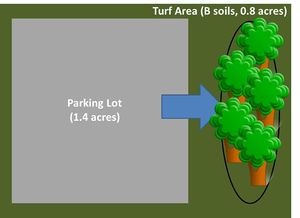
A tree trench system is to be constructed in a watershed that contains a 1.4 acre parking lot surrounded by 0.8 acres of pervious area (turf area and the tree trench BMP area). All of the runoff from the watershed will be treated by the tree trench system. The soils across the area have a unified soils classification of SM (HSG type B soil). The surface area of the tree trench basin is 5600 square feet at the media surface. The area at the media-soil interface is 3320 square feet. The total media depth will be 4 feet. Following the MPCA Construction Stormwater General Permit requirement, the water in the media of the tree trench needs to drawdown in a 48 hour time period. The media will be Media Mix D, which is a loamy sand composition resulting in a difference between the media wilting point and field capacity of 0.05 cubic feet per cubic foot and a difference between the media porosity and field capacity of 0.35 cubic feet per cubic foot. The tree trench will be planted with 10 medium sized deciduous trees. The following steps detail how this system would be set up in the MIDS calculator.
Step 1: Determine the watershed characteristics of your entire site. For this example we have a 2.2 acre site with 1.4 acres of impervious area and 0.8 acres of pervious area in type B soils. The pervious area includes the turf area and the area of the tree trench basin.
Step 2: Fill in the site specific information into the “Site Information” tab. This includes entering a Zip Code (55414 for this example) and the watershed information from Step 1. The Managed turf area includes the turf area and the area of the tree trench basin. Zip code and impervious area must be filled in or an error message will be generated. Other fields on this screen are optional.
Step 3: Go to the Schematic tab and drag and drop the “Tree trench system/Box (w/o underdrain)” icon into the “Schematic Window”
- MIDS calculator screen shots. Click on an image for enlarged view.
Step 4: Open the BMP properties for the tree trench by right clicking on the “Tree trench system/Box (w/o underdrain)” icon and selecting “Edit BMP properties”, or by double clicking on the “Tree trench system/Box (w/o underdrain)” icon.
Step 5: Click on the “Minnesota Stormwater Manual Wiki” link or the “Help” button to review input parameter specifications and calculation specific to the “Tree trench system/Box (w/o underdrain)” BMP.
Step 6: Determine the watershed characteristics for the tree trench. For this example the entire site is draining to the tree trench. The watershed parameters therefore include a 2.2 acre site with 1.4 acres of impervious area and 0.8 acres of pervious turf area in type B soils. There is no routing for this BMP. Fill in the BMP specific watershed information (1.4 acres on impervious cover and 0.8 acres of Managed turf in B soils).
Step 7: Enter in the BMP design parameters into the “BMP parameters” tab. Tree trench systems requires the following entries.
- Surface area at media surface which is 5600 square feet;
- Bottom surface area (area at media-soil interface) which is 3230 square feet;
- Media depth which is 4 feet;
- Media field capacity minus wilting point which is 0.05 cubic feet per cubic foot;
- Media porosity minus field capacity which is 0.35 cubic feet per cubic foot;
- Tree type is Deciduous;
- Tree Size is Medium;
- Number of Trees is 10;
- Underlying soil – Hydrologic Soil Group which is SM (HSG B; 0.45 in/hr) from the dropdown box; and
- Required drawdown time (hrs) which is 48 from the dropdown box.
Step 8: Click on “BMP Summary” tab to view results for this BMP.
Step 9: Click on the “OK” button to exit the BMP properties screen.
Step 10: Click on “Results” tab to see overall results for the site.

